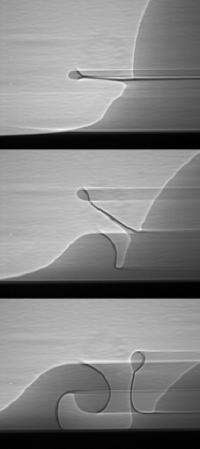How to make a splash

(Phys.org) -- A team of physicists has used the high-energy x-rays of the Advanced Photon Source (APS) at Argonne National Laboratory to penetrate the everyday mystery of a splash, revealing previously hidden structures and dynamics.
Sometimes, the simplest and most common things are also the most complicated. Consider a raindrop falling into a lake or the ocean – a gentle, elemental event that has occurred innumerable times every single day since liquid water has existed on Earth. Yet its precise nature remains largely unknown, even after more than century of careful experiment and observation. It’s a question of more than simply fundamental interest, because the manner in which splashes create and disperse miniscule droplets in their surroundings holds critical implications in the many industrial applications dependent upon the control of liquids. The major obstacle in understanding the physics of droplet splashing has been the difficulty of directly observing and recording the phenomenon in detail, because it happens so quickly and at an extremely small scale. In recent years, high-speed video imaging has largely resolved the problems of time and scale, but the internal structure of the droplet and splash eluded observation.
Working at the Argonne X-ray Science Division 32-ID beamline at the APS, the researchers from the University of Michigan and Argonne used both optical and phase-contrast x-ray imaging to capture images of the impact of a drop of silicone oil into a deep pool of the same liquid. Different viscosities and drop velocities were used to examine their effects on splash behavior.
The rough outlines of the inner structure of the splash have been known for some time. When a drop impacts the surface of a liquid pool, a sheet-like jet called the lamella spreads outward immediately, followed by the break-up of its leading edge into a secondary halo of droplets. But recent work, including mathematical modeling by Weiss and Yarin in 1999 showed that the splash is even more complex. The lamella is actually preceded by an ejecta sheet of even finer droplets that emerges from the “neck” area between the drop and the pool surface, as verified experimentally by Thoroddsen in 2002.
One of the main objectives of the current experiment was to identify the role of this ejecta sheet and determine how to distinguish it from the lamella.
“The usual way that people have always thought about this is that there is a sort of single jet [the lamella] that comes up,” said principal investigator Robert Deegan from the University of Michigan.
“But what the work at the APS revealed is that there are really two distinct jets, and that when you see one of them it’s actually because the two of them have merged.”
The experimenters found that the dynamic behavior of the splash is largely dependent upon the Reynolds number (involving fluid viscosity) and the Weber number (surface tension), dimensionless numbers that express ratios rather than exact units.
After observing splashes over a wide range of Reynolds and Weber numbers, Deegan and his colleagues developed a phase diagram showing four basic regimes: (1) the drop simply merges with the fluid and forms capillary waves; (2) a single jet appears; (3) the ejecta forms followed by a thicker lamella; and (4) the ejecta and lamella form, but the ejecta disintegrates into microdroplets.
“As you vary the impact speed and the properties of the liquid, you switch from one regime in which they’re clearly separated to the other regime in which they’re joined together,” said Deegan. “Another way to think about it is that as the liquid properties change, the interval of time between when the ejecta comes out and when the lamella comes out gets smaller and smaller until they’re essentially commingling.”
This work confirms definitively that the splash consists of two distinct jets, but that the structural dynamics are strongly dependent upon the various parameters involved, with a continuous jet at low Reynolds numbers and two distinct jets at higher Reynolds values.
“The really surprising thing was the way that these two jets merge. You vary the parameters by one percent, which is minor, and suddenly the qualitative character of the splash is different,” Deegan said.
The next experimental vista for the team involves considering how additional parameters affect the splash behavior, such as the surrounding air pressure. “It can actually qualitatively change the splash,” Deegan said, “which is actually a bit surprising, because the air is a thousand times less dense and its viscosity is a hundred times less than the liquid, so you would think that these effects would be minor. But they can be significant.”
The team also wants to understand how the size and number of the liquid jets are determined. “We can measure empirically the number of jets and say the thickness and speed of the jets, but we don’t really understand why they have that behavior,” Deegan said.
Study co-author Kamel Fezzaa of Argonne said, “We are constantly working on improving this technique with faster frame rates, shorter exposure times, and the addition of other complimentary techniques including diffraction and spectroscopy.”
Already, the researchers have used the x-ray phase-contrast technique to break through a long-standing barrier that obscured understanding of this common mystery.
“Just being able to see these things with the APS, whereas before we were very limited by optics, was a huge revelation to us,” Deegan said. “I can’t overemphasize what a big difference it made.”
More information: L. V. Zhang, et al. “Evolution of the ejecta sheet from the impact of a drop with a deep pool,” J. Fluid Mech. 690, 5 (2012). DOI:10.1017/jfm.2011.396
Provided by Argonne National Laboratory


















